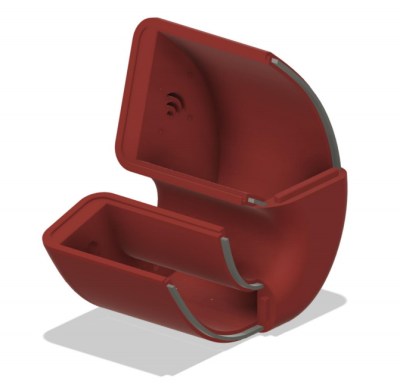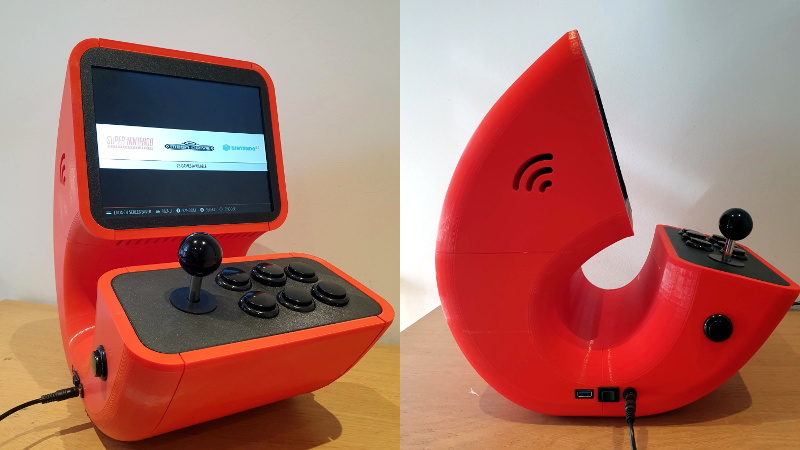Let’s be honest, building a home arcade cabinet isn’t exactly the challenge it once was. There’s plenty of kits out there that do all the hard work for you, and they even sell some pretty passable turn-key units at Walmart now. If you want to put a traditional arcade cabinet in your home, it’s not hard to get one.
Which is why this wild build by [Rafael Rubio] is so interesting. The entirely 3D printed enclosure looks like some kind of art piece from the 1970s, and is a perfect example of the kind of unconventional designs made possible by low-cost additive manufacturing. Building something like this out of wood or metal would be nightmare, especially for the novice; but with even a relatively meager desktop 3D printer you’re only a few clicks away from running off your own copy.

Inside the nautilus-like enclosure is a Raspberry Pi running Retropie, a 10″ LCD panel from Pimoroni, and a GeeekPi interface board that connects up to the 8-way joystick and arcade buttons. [Rafael] has included a Bill of Materials and an assembly overview that you can follow along with, though the cavernous internal dimensions of the enclosure certainly give you ample of room for improvisation if you’d rather blaze your own path.
Like the retro-futuristic computer terminals created by [Oriol Ferrer Mesià], this arcade machine completely reinvents a traditional design that most people take for granted. Is this layout actually better than the standard arcade cabinet? It’s not really our place to say. But it’s certainly a new and unconventional approach to “solved” problem, and that’s what we’re all about.
















I don’t get why “Raspberry Pi running an ancient build of MAME” is so popular as a choice for arcade emulation rather than running an actual modern build of MAME (on suitable hardware) with however many thousands of bug fixes.
Because that’s not what people are running. Retropie includes lots of emulators, MAME is just one of them. You can see from the photos that he’s running Megadrive and SNES games.
That’s weird, I thought you could run Megadrive and SNES emulators on a PC, too. Today I learned, thanks. /s
No-one said you couldn’t. People have different requirements, a PC isn’t right for everyone, which is why Retropie is popular.
MAME is hella bloaty is why. MAME is a bit of a problem in that it’s a critical mass blackhole in the emulation universe everything gets sucked towards it. I get why it exists, I get why it does things the way it does, BUT it is not the best way to do it for specific machines or specific (limited) target hardware. It should be the reference implementation, sure.. it should not be THE implementation for 90% of use cases. But since everything shall be MAME, if you want lightweight you go back to a lighter weight MAME if you want quick and easy.
Before it, efficient emulation saw individual emulators at between 10:1 and 5:1 between emulated speed and CPU speed of target architecture. A lot of these got to 99.9% perfect if developed for long. MAME is some kind of ridiculous one hundred to several hundreds to one, oh a 2Mhz 8 bit? yeah you’ll need 1Ghz to run that smooth. Having run numerous 8 bit emulators capable of full or even double speed if you wanted, on then current 90s 12-100Mhz 32bit CPUs, I find this abysmal. I get it, it’s register correct, down to the last bit, but that don’t make it useful for playing. I recall when some games were ruined for playability mid noughties, when a “technically correct” update made the emulation resources inadequate for several games, so instead of the fast, playable emulation, you got the bit twiddlers circle jerk version, yeah it was “fixed” by telling you to run on faster systems.
I’m not saying MAME shouldn’t exist, I’m saying people should realise what it is, a digital archivists wet dream, not an emulator targeted for playability with ANY constriction on hardware requirements. (You’ll be scrabbling for used i9s or Ryzen 7s in 2 years just to run the games you run on middling i5s now)
Few people are actually running arcade games on these things though, they are using them to play console games from their youth.
This thing looks sweet. I hope it is equipped with good suction cups.
Yes, I can see it rocking when the play gets intense.
What’s that saying?
“If the MAME is rocking, don’t bother…”
Heh, I never found suction cups any good on joysticks, I always wanted to have them bolted through the desk, preferably with a metal backing plate, or at least huge washers.
Nice design!
I’ll need to add some lag bolt holes if I’m going to play Street Fighter II on that ;)
Nice work.
Really impressive design, looks like something that could have been!
“is a perfect example of the kind of unconventional designs made possible by low-cost additive manufacturing.”
Gotta nitpick that, FDM might make it easier but it’s not unpossible to make that shape with other techniques. (Some of which, surprise surprise, would have been used in the 70s to make 70s looking objects :-P ) I can think of 3 ways to get a definite result (produced to exact dimensions) and a couple of ways to get a close result (will look about the same but if you’re gonna quibble the exact radiuses etc aren’t.) though iteration and fine tuning might get them pretty damn close. Might not even take that long to do it in plywood if you’ve got a router and a modest selection of bits.
Yeah but the average person doesn’t have the skill or tools required to make something like this out of wood or metal. Desktop 3D printing is an equalizer, in that anyone can just click a button and have their own copy of his design.
Yeah there’s some tweaking involved with desktop printers and it’s not literally “click and forget” like a paper printer, buts it’s still orders of magnitude easier than traditional production.
The average person doesn’t have a 3D printer either yet, there’s about one per 2,000 people. If the tales of piles of wonky worn out printers at hackerspaces are true, there’s an actually working one per 8,000 or so.
I’d put the availability of tools to do one of the alternate methods at at least one per 100. I go to yard sales in season and weather and virii permitting, and I see basic saws at at least 1 in 10, and routers at about 1 in 50. At around 200 yard sales a year, since I became aware of ready made “commodity” 3D printers, circa 2012, 8 years, I have not seen one at a yard sale, saw filament once, last year, guy who had a bunch of surplus/returned/mis-shipped goods, but that’s as close as I got in 1600 samples.
Hi, background about the project:
First I tried a wood version: http://woodandbits.com/wood-e . But it was too expensive. After that I decided to change to FDM printable version and share it.
Do you have a youtube channel showing the process? I loved the results!
Love the design, it looks like a 70’s phone, actually if you thinned the width you could build a bluetooth handset into the case for your cellphone. (For like at night when you don’t want to feel around for your phone.)
I love the look. It looks like something Alex would of played with in A Clockwork Orange.